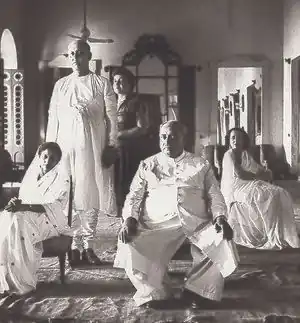Khwaja Habibullah
Nawab Khwaja Habibullah Bahadur (26 April 1895 – 21 November 1958)[1] was the fifth Nawab of Dhaka. He was the son of Nawab Sir Khwaja Salimullah Bahadur. Under Habibullah's rule, the Dhaka Nawab Estate went into decline until its actual relinquishment in 1952 by the East Pakistan Estates Acquisition Act.
| Nawab Khwaja Habibullah Nawab of Dhaka | |
|---|---|
 Habibullah in 1947 | |
| Reign | 1915–1958 |
| Predecessor | Nawab Khwaja Salimullah |
| Successor | Khawja Hassan Askari |
| Born | 26 April 1895 Ahsan Manzil, Dacca, Bengal Presidency, British India |
| Died | 21 November 1958 (aged 63) Shahbag, Dhaka, East Pakistan |
| Burial | Begum Bazaar, Dhaka |
| Spouses |
|
| House | Dhaka Nawab Family |
| Father | Nawab Khwaja Salimullah |
Biography
Habibullah was born on 26 April 1895 in Dhaka.[2] His father was Nawab Sir Khwaja Salimullah Bahadur of the Dhaka Nawab family. The Nawab family traced its ancestry to Kashmiri merchants who settled in Bengal for trade.[3] Habibullah went to school at St. Paul's School in Darjeeling, and later continued his education in England.[2] In 1915, at the death of his father, he succeeded as the Nawab of Dhaka.[2]
In 1918, Habibullah joined the Bengali Platoon of the British Indian Army. He served in the British mandate of Mesopotamia as an honorary lieutenant.[2] He served in Dhaka district board and Dhaka municipality board. He took part in the Khilafat Movement.[2] He was the representative of Dhaka in the Bengal legislative council from 1924 till 1932.[2]
Habibullah had supported the 1932 communal award proposal of the British Raj. In 1935 he was the president of the Bengal Muslim League and member of the executive council of the All India Muslim league.[2] From 1937 to 1941 he was a minister in the cabinet of A. K. Fazlul Huq.[2] He joined the second cabinet of Haq against the wishes of the Muslim League for which he was suspended from the league till 1946. In 1946, he stood in the assembly election of Bengal as an independent candidate but suffered a heavy defeat at the hands of his relative, Khwaja Khairuddin who was on a Muslim League ticket.[2]
Habibullah presided over the committee that organized the Pakistan Independence Day celebrations in Dhaka, and, on 15 August 1947, raised the flag of Pakistan at Lalbagh Fort.[4] After the partition of India he held the position of vice-president in East Pakistan Muslim League.[2] During his reign as the Nawab of Dhaka, the estate continued the decline that had begun under his father.[5]
Personal life and death

Habibullah was married to Ajmiri Begum, Shahriar Khanam (d. 1931), Khurshidi Begum, Amirun Bibi and Ayesha Begum (d. 2008).[6] He had a total of five sons and two daughters.[6] Habibullah's cousin, Khwaja Nazimuddin, was the Prime Minister of Pakistan during 1951–1953.[7]
In later days, he retired from politics because of health related reasons. He left the Ahsan Manzil Palace and resided in another of the royal residences, Green House, in Dhaka's Paribagh. He died on 21 November 1958 and was buried alongside his father at the Nawab family graveyard in Begumbazar in Dhaka.[2]
References
- Punekar, S. D.; Varickayil, Robert; Savur, Manorama; Dighe, Sunil; Ganesh, Kamala; Research, Indian Council of Historical (1988). Labour Movement in India: 1937-1939. Indian Council of Historical Research. p. 1117. ISBN 9788173071065.
- Sirajul Islam; Miah, Sajahan; Khanam, Mahfuza; Ahmed, Sabbir, eds. (2012). "Habibullah, Khwaja". Banglapedia: the National Encyclopedia of Bangladesh (Online ed.). Dhaka, Bangladesh: Banglapedia Trust, Asiatic Society of Bangladesh. ISBN 984-32-0576-6. OCLC 52727562. OL 30677644M. Retrieved 25 October 2023.
- Hundred Years of Bangabhaban, 1905-2005. Press Wing Bangabhaban. 2006. p. 20. ISBN 978-984-32-1583-3.
It was at this time that a recently settled Muslim trading family of the city of Dhaka, originally from Kashmir, gave up trade and invested their wealth in buying land from the auctions. The founder of this Kashmiri Muslim family in Dhaka was Khwaja Alimullah.
- Kudaisya, Gyanesh; Tan, Tai Yong (2005) [First published 2000]. The Aftermath of Partition in South Asia. Routledge. p. 61. ISBN 0-415-28908-4.
- Alamgir, Md. (2005). A Short Note on Ahsan Manzil Museum and the Nawabs of Dhaka. Dhaka: Jhingephul. p. 18.
Nawab Sir Salimullah could not properly take care or direct the Estate due to his heavy involvement with politics. The revenue income of the estate decreased and the Nawab ran into large debts ... During the time of Nawab Habibullah, the Nawab Estate fell into very miserable conditions because of mismanagement.
- "Family Tree". www1.tribalpages.com. Retrieved 13 June 2022.
- "Special report: Parliament in Chaos 1951-1958". Dawn. 25 August 2017. Retrieved 13 June 2022.